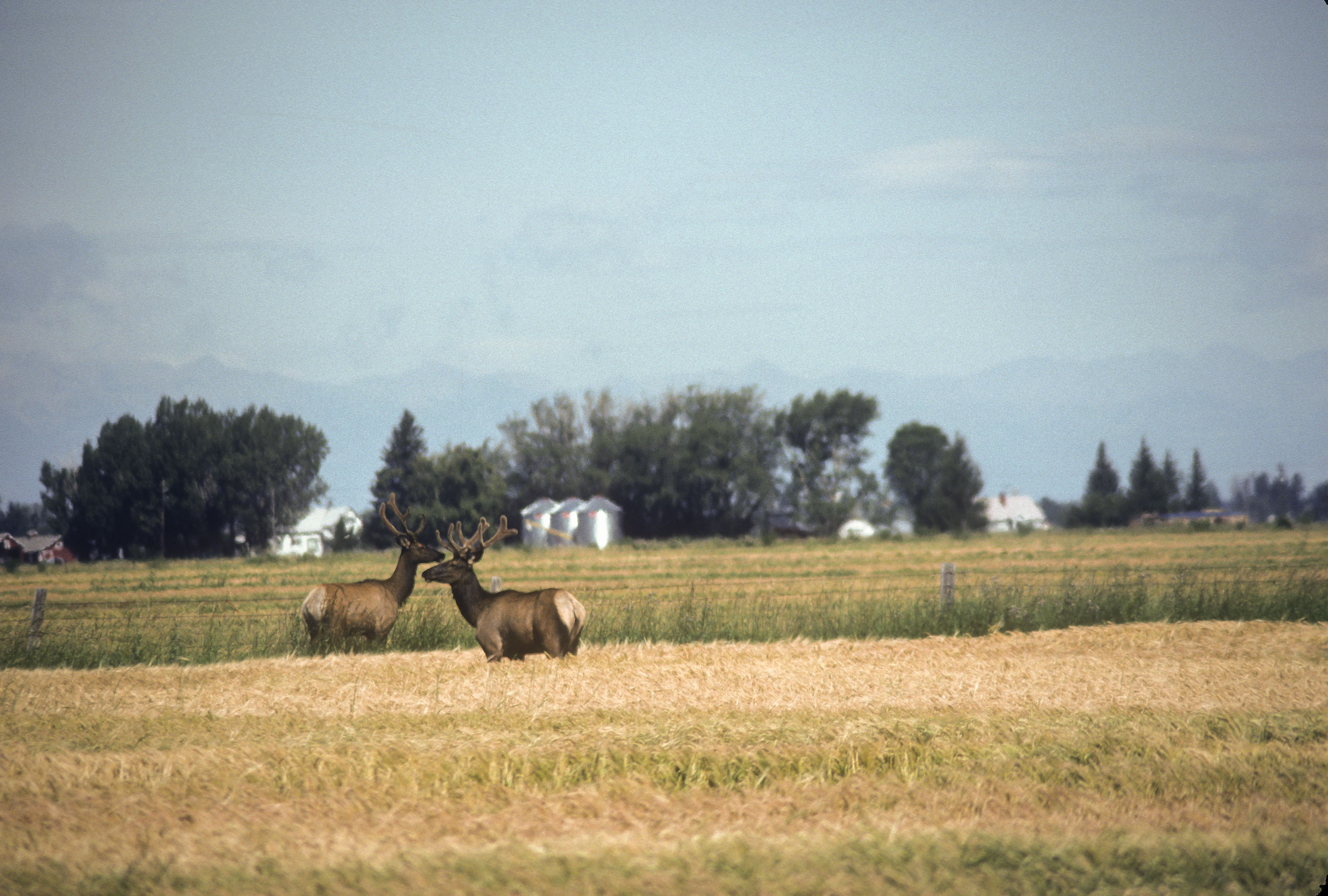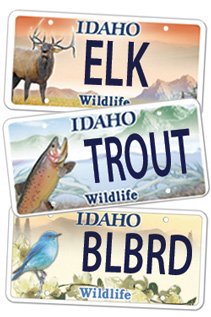Wildlife Depredations

Not everyone loves elk like wildlife enthusiasts do. When elk enter summer crops like this field near Rigby, they can cause significant damage.
It started with a Facebook post earlier this month showing a bunch of elk quarters in a locker. The story continued that Idaho Department of Fish and Game had killed 206 elk for research in cooperation with the University of Idaho. I heard about it when I read a diatribe in the Island Park News critical of the action, saying that these elk were worth about $1.5 million to the state (of Wyoming not Idaho) and suggesting that the Idaho legislature needed to tighten control on the Department so such shameful activities wouldn’t happen.
My 30 years of experience with the Department led me to believe that there was more to the story and that the posting was, at very least, misleading. I found a report from Magic Valley (https://www.boisestatepublicradio.org/post/after-viral-facebook-post-idaho-fish-and-game-explains-elk-killings#stream/0) that did a good job explaining exactly what was happening. First, these animals were causing depredation (damage) to private ground. This usually means that they are in unharvested crops in the summer and haystacks in the winter—basically elk candy stores. The elk removal was spread from Weiser almost to Arco on five different farms, five different game units and over a four-month period. All meat was donated to local food banks, nothing was wasted. The highest kill in one night was seven animals.
A question came up; why weren’t sportsmen allowed to do the harvesting? Good question. The answer was that these elk, like most marauding elk, did their deeds at night, when, 1) it isn’t legal to hunt, and 2) it is dangerous without specific controls and training. In my opinion, it would have been irresponsible to use anyone other than trained staff under strict safety guidelines to conduct this exercise.
The study is a graduate level study looking for ways to reduce depredations through lethal and non-lethal means. If I was designing this study, I would certainly wonder if the killing of a single elk would be enough to dissuade the others. Two elk? All the elk in the field? I worked in depredations for several years and I found elk to be stubborn and persistent and crazy smart so, just what would it take to get them to move on? The nature of scientific research like this requires repetition and testing over different sets of conditions. If lethal removal is considered, it is going to require a substantial body count to come up with any answers.
So, why do we need the answers at all? That goes back to the complaint in the Island Park News stating that the legislature should hold the reins more tightly on the Department. In 1988, drought forced wildlife, mostly pronghorn antelope, onto private ground literally in droves. Thousands of pronghorns descended on fields in the Mud Lake and Howe areas damaging crops worth many hundreds of thousands of dollars. The Legislature got involved, demanding that the Department reimburse landowners for losses and develop a depredation control and payment plan for wildlife damage to crops. Last year alone, depredations reportedly cost the Magic Valley Region $1,598,720. The Upper Snake Region is often close behind. The Southwest, Southeast, Salmon and Clearwater regions also routinely pay high dollars for claims. So, in answer to the question, why doesn’t the legislature become involved, they did and this, including this study, is what it looks like.
Balancing wildlife and agricultural interests in a state still run largely by agriculture is always going to require maintaining wildlife populations at lower numbers than the habitat can sustain. If these 206 elk can help in finding the way to do that most effectively, then elk herds and sportsmen will ultimately benefit and it will be a worthy sacrifice.
Wildlife License Plates
Great news! as of 2024, there are three NEW designs for license plates. They still are bluebird, cutthroat trout and elk, but they are beautiful.
Idaho Wildlife license plates provide essential funding that benefits the great diversity of native plants and wildlife that are not hunted, fished or trapped—over 10,000 species or 98% of Idaho’s species diversity. Game species that share the same habitats (such as elk, deer, antelope, sage-grouse, salmon, trout) also benefit from these specialty plates.
No state tax dollars are provided for wildlife diversity, conservation education and recreation programs. Neither are any revenues from the sale of hunting or fishing licenses spent on nongame species. Instead, these species depend on direct donations, federal grants, fundraising initiatives—and the Idaho Wildlife license plates.
Both my vehicles have Bluebird Plates. I prefer the bluebird because the nongame program gets 70 percent of the money from bluebird plates, but only 60 percent of the money from elk and trout plates - 10 percent of the money from elk plates supports wildlife disease monitoring and testing programs (to benefit the livestock industry) and 10 percent from cutthroat plates supports non-motorized boat access.
Incidentally, in 2014, the Idaho Legislature denied the Department of Fish and Game the ability to add new plates or even to change the name of the elk and cutthroat plates (very specific) to wildlife and fish plates, a move that would have allowed for changing images occasionally and generating more revenue. It would seem that they believe that we Idahoans don't want a well funded wildlife program.
I think it is time we let the Legislature know that Idahoan support wildlife funding and that we would like to see these generic plates come to fruition.
Help Idaho Wildlife
When we traveled across the state in October 2017, we visited most of the Idaho Department of Fish and Game wildlife management areas. Most of the vehicles we saw using the wildlife management areas did not have wildlife plates. Buying wildlife plates is a great way for non-hunters and hunters alike to support wildlife-based recreation like birding.
C'mon folks, let's help Idaho's wildlife by proudly buying and displaying a wildlife license plate on each of our vehicles!
See below for information on Idaho plates. Most states have wildlife plates so if you live outside Idaho, check with your state's wildlife department or vehicle licensing division for availability of state wildlife plates where you live.
And tell them that you heard about it from Nature-track.com!

Wildlife License Plates
Great news! as of 2024, there are three NEW designs for license plates. They still are bluebird, cutthroat trout and elk, but they are beautiful.
Idaho Wildlife license plates provide essential funding that benefits the great diversity of native plants and wildlife that are not hunted, fished or trapped—over 10,000 species or 98% of Idaho’s species diversity. Game species that share the same habitats (such as elk, deer, antelope, sage-grouse, salmon, trout) also benefit from these specialty plates.
No state tax dollars are provided for wildlife diversity, conservation education and recreation programs. Neither are any revenues from the sale of hunting or fishing licenses spent on nongame species. Instead, these species depend on direct donations, federal grants, fundraising initiatives—and the Idaho Wildlife license plates.
Both my vehicles have Bluebird Plates. I prefer the bluebird because the nongame program gets 70 percent of the money from bluebird plates, but only 60 percent of the money from elk and trout plates - 10 percent of the money from elk plates supports wildlife disease monitoring and testing programs (to benefit the livestock industry) and 10 percent from cutthroat plates supports non-motorized boat access.
Incidentally, in 2014, the Idaho Legislature denied the Department of Fish and Game the ability to add new plates or even to change the name of the elk and cutthroat plates (very specific) to wildlife and fish plates, a move that would have allowed for changing images occasionally and generating more revenue. It would seem that they believe that we Idahoans don't want a well funded wildlife program.
I think it is time we let the Legislature know that Idahoan support wildlife funding and that we would like to see these generic plates come to fruition.

"WOW. What a phenomenal piece you wrote. You are amazing." Jennifer Jackson
That is embarrassing, but actually a fairly typical response to my nature essays. Since The Best of Nature is created from the very best of 16 years of these nature essays published weekly in the Idaho Falls Post Register (online readership 70,000), it is a fine read. It covers a wide variety of topics including humorous glimpses of nature, philosophy, natural history, and conservation. Readers praise the style, breadth of subject matter and my ability to communicate complex and emotional topics in a relaxed and understandable manner.
Everyone can find something to love in this book. From teenagers to octogenarians, from the coffee shop to the school room, these nature essays are widely read and enjoyed.
Some of the essays here are my personal favorites, others seemed to strike a chord with readers. Most have an important message or lesson that will resonate with you. They are written with a goal to simultaneously entertain and educate about the wonderful workings of nature. Some will make you laugh out loud and others will bring a tear to the eye and warm your heart.
Readers Write:
"You hit a home run with your article on, Big Questions in Nature. It should be required reading for everyone who has lost touch with nature...great job!" Joe Chapman
"We enjoyed your column, Bloom Where Planted. Some of the best writing yet. The Post Register is fortunate to have your weekly columns." Lou Griffin.
To read more and to order a copy, click here or get the Kindle version
Copies are also available at:
Post Register
Island Park Builders Supply (upstairs)
Barnes and Noble in Idaho Falls
Harriman State Park, Island Park
Museum of Idaho
Valley Books, Jackson Wyoming
Avocet Corner Bookstore, Bear River National Wildlife Refuge, Brigham City, Utah
Craters of the Moon National Monument Bookstore, Arco, Idaho